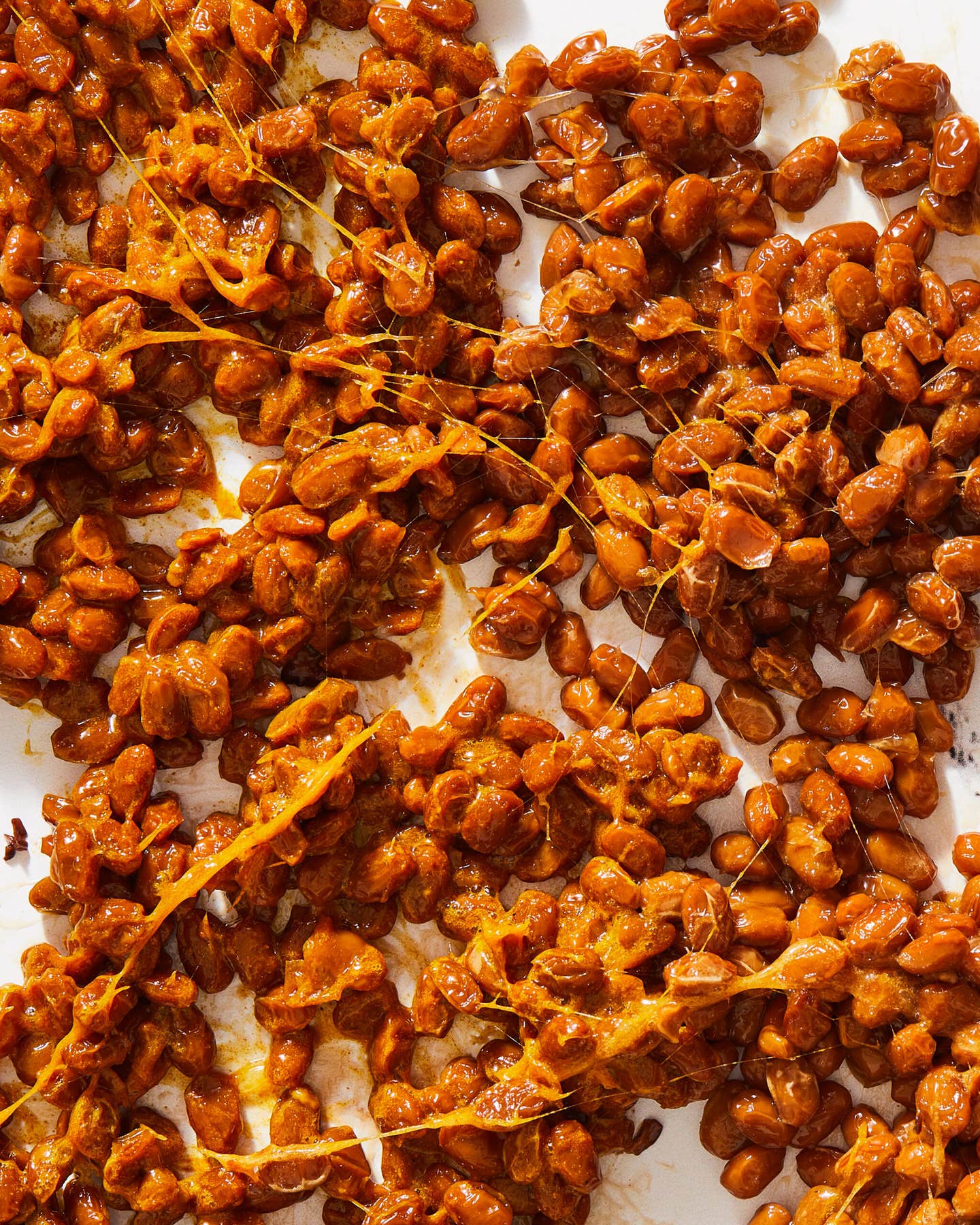
There’s a Lot to Love About Natto
How to acquire a taste for Japan’s sticky, gooey, funky fermented beans.
If you hope to live a long life, chances are you’ve researched, or at least speculated, what makes Japan’s average life expectancy the highest in the world. Many research findings have connected Japanese longevity to certain food and drink staples, from fish to green tea. Among the hailed ingredients is a slippery, slimy one that’s beloved in Japanese culture but has yet to make its way into the hearts and minds of the global masses: natto, an all-around miraculous food.
Natto is made by steaming soybeans, then inoculating them with a microorganism known as Bacillus subtilis, explains Ann Yonetani, a microbiologist and founder of the natto company NYrture. As a result of fermentation, the soybeans develop a sticky, stringy texture and a nutty, pungent flavor, somewhat reminiscent of aged cheese.
My dad, who spent time working in Japan and speaks the language, instilled in me an early appreciation for natto. At breakfast, he’d scoop a little into my bowl of porridge, or slide a jar toward me encouragingly as I ate my scrambled eggs—often while remarking, “it’s really good for you”—before gobbling up a helping of his own. At first I merely tolerated natto’s presence in my bowl, but eventually, I missed its funky aroma whenever it wasn’t on the table.
If no one ever coaxed you to acquire a taste for natto when you were a kid, it’s not too late to acquire it now—and it turns out there are lots of good reasons to do so. It’s no secret that fermented foods are advantageous for gut health, but one way Bacillus subtilis differs from the bacteria in many other fermented items is that it has the ability to form spores. “The spores are able to survive the extremely acidic conditions of the stomach and make it through your digestive system,” explains Yonetani. These beneficial microbes can then join the community of bacteria that populate the intestines, where they contribute to a more diverse gut microbiome, which in turn supports healthier immune and digestive function.
Natto also contains more Vitamin K2 than any other known food source, notes Yonetani, explaining that the micronutrient is critical for calcium metabolism. Studies published in The Journal of Nutrition associate natto consumption with lower risk of osteoporotic fracture and bone density loss. It could support heart health, too, as eating fermented soy products like natto and miso is also linked to lower risk of death by cardiovascular disease, according to a study in The BMJ (British Medical Journal). “Really good for you” indeed.
In Japan, many people wake up to fermented soybeans. “It’s really very popular as a breakfast dish,” says Jane Matsumoto, director of culinary arts at the Japanese American Cultural & Community Center (JACCC). Perhaps that’s because natto is exceptionally filling, with more than 30 grams of protein in a single cup—something Yonetani says she especially appreciated after transitioning to a vegan lifestyle. Plus, natto is easy to prepare: simply scoop the savory ingredient right out of the jar and dollop it over rice, or stir some into a bowl of miso soup, and breakfast is served.
Those curious about natto’s health-boosting benefits can now find it in a variety of forms—from natto powder to capsules of isolated nattokinase (an enzyme found in natto that’s especially linked to cardiovascular benefits)—but there’s nothing like enjoying Japan’s gift to nutrition in all its funky, slippery glory.“Natto is an amazingly simple, two-ingredient food that produces something so unique, with marvelous flavor and texture,” says Yonetani.
In the U.S., look for natto in Japanese markets and Asian grocers, and on e-commerce retailers like Umamicart. The ingredient typically comes with little packets of karashi (Japanese mustard) and a soy sauce-based seasoning for stirring into the beans before eating, but there are myriad ways to enjoy the ingredient. “I think natto is a lot more versatile than the traditional Japanese applications,” Matsumoto notes.
Here are some different techniques for integrating natto into your next meal:
Enjoy natto with rice.
An easy, popular preparation I often whip up quickly for breakfast is natto gohan, which calls for dolloping the fermented beans over steamed rice, then garnishing with toppings like scallion and tsukemono (a variety of Japanese pickles). But don’t stop there. Chris Ono, the chef behind the JACCC’s restaurant concept Hansei, likes eating natto with yaki onigiri, or grilled rice balls, which have a crispy texture that contrasts delightfully with the gooey natto. “I break the onigiri open and put the natto in the middle,” he says. Ono also rolls the soybeans into maki with scallion and takuan, or pickled daikon—a sweet, crunchy addition that helps “cut the intensity” of the natto, he adds.
Pair natto with similarly viscous ingredients.
In Japanese cuisine, natto often shows up alongside other viscous foods (Japanese language describes that sticky texture as neba neba). “I call it slime on slime,” says Matsumoto, who loves pairing natto with okra. Grated yamaimo, or mountain yam, is another terrific partner for the ingredient—the sticky combination makes a tasty topping for any rib-sticking bowl of carbs, be it noodles, rice, or porridge. Raw egg, a typical garnish for natto gohan, also makes for a satisfyingly slurpable concoction.
Toss natto into a stir-fry.
The next time you whip up a stir-fry, try tossing in some fermented soybeans. “Think of natto as a main protein,” suggests Ono, pointing out the ingredient’s savory flavor and meaty chew. Earthy ingredients like mushrooms marry nicely with the nutty quality of natto, he says, while alliums like garlic and onion enhance its umaminess. Just be sure to add the natto at the very end of the cooking process, Yonetani advises, so you don’t apply too much heat, which could kill those friendly bacteria.
Complement natto with your favorite cheese.
Anything you might top with cheese, you can probably consider adding some natto to it, says Yonetani, pointing out that the two are similarly pungent. She regularly mixes them in dishes like grilled-cheese sandwiches, scrambled eggs, and pasta—and swears that Parmesan cheese is an especially exquisite complement for natto (Japanese and Italian seasonings are known to be harmonious, after all). If it’s hard for you to get past the beans’ stringy quality, consider folding some into a cheesy, velvety dip. The soybeans add crunch, while their slippery texture incorporates subtly into the creaminess of the dip.
Add sweetness and spice.
Seasonings for natto aren’t limited to karashi and soy sauce. Got some sriracha, Tabasco, salsa macha, or chile crisp on hand? I love drizzling any of these fiery condiments over top to heat things up. Ono recommends sprinkling in shichimi togarashi (a seven-spice mix that includes red chiles, sansho pepper, dried orange peel, and sesame seeds) or stirring in yuzu kosho (a fermented condiment made with chiles and yuzu) to jazz up your natto with a citrusy, spicy boost. Or, follow Yonetani’s suggestion and experiment with stirring in different salad dressings. From sweet honey mustard to tart balsamic vinaigrette, the flavor profiles you can create are endless.
Recipe

Keep Reading
Continue to Next Story










